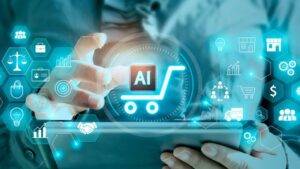Data conversion is a complex task, which necessitates more than simply file type conversion or database migrations. Proper planning must take place to account for resource limitations and complexity of data.
Asses each AI tool against practical criteria such as how quickly it integrates with existing systems and whether team members can quickly learn it. Before making the final decision to implement AI tools into your systems, ensure a comprehensive check has been performed in order to detect any compatibility issues and address them as soon as possible.
1. Predictive Analytics
Have you ever used past KPI benchmarks and competitor research to predict how your organization will fare this quarter? That is predictive analytics in practice – except it uses artificial intelligence (AI) models instead to make real-time predictions based on more data sets in real time.
By analyzing historical purchase and product usage data, you can predict which products or services a customer is likely to purchase in the future. With this knowledge at hand, it becomes possible to tailor marketing messages specifically to each customer, remind them about products they’ve forgotten in their carts or even offer discounts on that exact item they’ve been searching for.
Predictive analytics has many uses in healthcare, and one major application involves the prediction of treatments or interventions for chronic diseases, which account for $3.5 trillion annually in healthcare spending. Being able to predict risk can help optimize patient care while simultaneously cutting costs by targeting individuals most at risk of flare-up.
Statistical models can also help marketers identify groups of customers based on shared behaviors, such as those who frequent kitchen gadget stores late at night. You can then develop personalized messaging to keep these customers engaged with your brand and prevent them from defecting to another one. As predictive analytics becomes more widely accessible and user-friendly, marketers can focus their efforts on keeping existing customers rather than seeking out new ones.
2. Data Science
Data science is an emerging discipline which uses raw data to extract and interpret insights. It brings together skills from statistics, computer science and mathematics with domain-specific expertise and domain knowledge for businesses to make sense of complex information – helping marketers develop more informed and successful marketing strategies.
Data scientists use predictive models and other advanced tools to understand customer behavior patterns, enhance current advertising campaigns, and plan future initiatives with confidence. Predictive modeling allows data scientists to quickly identify which customers are the most profitable – this allows them to target these individuals with personalized messages and offers. Data science can also be utilized to optimize marketing activities timing, predict customer responses to certain products or events, or determine which shipping method would work best.
Data science can be applied across numerous industries and any aspect of business operations, from healthcare to finance to retail ecommerce and beyond. Data science can assist in early disease diagnosis and drug discovery for healthcare, risk evaluation in finance, fraud detection in retail industry and supply chain optimization as well as attribution modeling in online retail environments.
3. Automation
As marketing teams strive to boost productivity and reduce costs, automation tools provide an ideal way of speeding up processes without increasing human workload. Automating tasks such as data entry, transcription and basic customer interactions frees marketers up time for more strategic work.
AI-powered marketing tools can assist marketers by simplifying tedious tasks and improving performance with data analysis. From scheduling social media posts to tailoring email content, these AI tools enable brands to offer customers personalized experiences while forging stronger bonds between themselves and customers.
Implementation is key when considering automation; prioritize areas where artificial intelligence (AI) will have the most significant effect. Choose an AI tool capable of handling most of your marketing workload while offering customization and expansion as necessary. Evaluate each AI option against practical criteria like ease of integration and whether or not it fits within existing systems in your business.
AI assists marketers to analyze large volumes of data to predict future consumer behavior and create more effective campaigns. By predicting conversion patterns, these tools can identify at-risk customers and suggest improvements, optimize channel selection, refine segmentation and establish optimal campaign delivery times. AI tools also automate A/B testing while offering real-time monitoring to measure progress – these may include predictive analytics or advanced attribution models which assign credit for each touchpoint along the path towards conversion.
4. Machine Learning
Machine learning refers to the practice of employing algorithms to analyze data, uncover patterns, and detect trends. It’s often employed alongside artificial intelligence as a means to enhance decision-making processes and automate tasks.
As our world becomes more digital, machine learning is becoming an ever-increasing presence in marketing. For example, machine learning can assist marketers with personalizing online advertising campaigns, data interpretation and behavior prediction as well as identify new markets and customer segments to optimize marketing performance.
Note, however, that AI-powered solutions depend on how well they’re trained. Furthermore, organizations should make sure the data used is representative and accurate; otherwise an algorithm used to interpret poor quality information will produce incorrect results. As a result, organizations must dedicate sufficient resources and time toward standardizing and cleaning up their data sets prior to introducing an AI-powered tool into their organization.
Marketers should keep abreast of developments in machine learning and keep themselves aware of challenges such as bias and security threats to respond accordingly. An AI tool without sufficient security protections could expose sensitive information leading to data breaches; as a result, businesses must develop accountability frameworks and policies to address such concerns.




